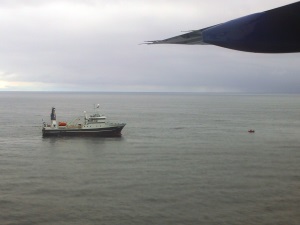MAGIC summer. Impressions from the summer campaign

All instruments seemed to work well at both ship and aircraft. This also includes the sampling of air for trace gas and isotopic analysis, and the procedures set up for this. Many flasks are already at NILU, and they seem to be OK for analysis after our first checks.
The weather seemed to be on our side, and basically the most ambitious flights were possible. It was even possible to find Helmer Hanssen and pass it, after some “looking around”.
No long range transport episodes of industrial pollution seem to have influenced the measurements last week, neither at the ship or Zeppelin. This is a great advantage as we are studying the natural sources and fluxes.
This campaign has provided us with a lot of data that we have to work with now.
Special thanks for the excellent work so far to those that were very active the last weeks!!

Summer campaigns in MOCA: ship and aircraft measurement
1st period at Research Vessel Helmer Hanssen
This is a result of close collaboration between MOCA and CAGE and UiT.
The ship left Longyearbyen on 19 June, and has been outside Prince Karl’s Forland since then doing transects in the most relevant areas. Follow the ship here: http://www.sailwx.info/shiptrack/shipposition.phtml?call=LAHVOcean and sub-sea measurements and activities:
The CAGE-UiT group is measuring in the water column and at sea floor analyzing e.g. CH4 in the ocean. During this first period GEOMAR and USGS are also at the ship; GEOMAR is studying bubble activity, and USGS are using a Picarro (CH4/CO2) and measuring in the surface water and at 2 different height levels at the ship. The crew on the ship will try to collect gas hydrate samples from different sediment cores to be sent to NILU for further analysis.
Atmospheric measurements and activities:
At Helmer Hanssen there is high time resolution of CH4, CO2, CO (Picarro), flask sampler collecting 1-6 samples per day (depending on the location) for isotope analysis and trace gases as ethane. All Picarro data are transferred to NILU every night and followed closely by the scientists at NILU.
2nd period of coordinated ship and aircraft campaign
A flight campaign is taking place during the first week of July, complementary to the ongoing ship campaign. We are using a large and very well equipped aircraft, (http://www.faam.ac.uk/) operated by the colleagues particularly from the University of Cambridge and University of Manchester. Flights tracks are above the ship and ocean outside Prince Karl’s Forland, there will be contact between the pilots and the ship. The aircraft will make attempts to fly as low as ca 100 ft.
